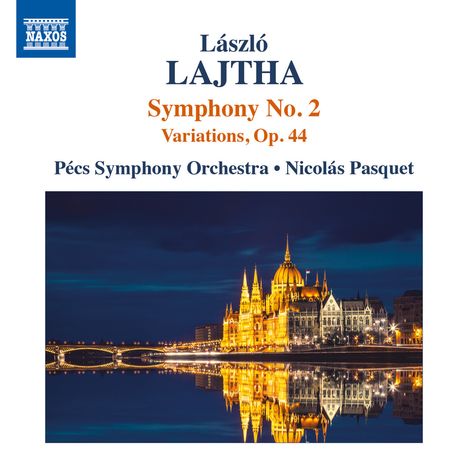Laszlo Lajtha: Symphonie Nr.2 auf CD
Symphonie Nr.2
Herkömmliche CD, die mit allen CD-Playern und Computerlaufwerken, aber auch mit den meisten SACD- oder Multiplayern abspielbar ist.
+Variationen op. 44
- Künstler:
- Pecs Symphony Orchestra, Nicolas Pasquet
- Label:
- Naxos
- Aufnahmejahr ca.:
- 1995
- Artikelnummer:
- 5123490
- UPC/EAN:
- 0747313364473
- Erscheinungstermin:
- 11.11.2016
Der Charakter der zweiten Symphonie steht in deutlichem Kontrast zu dem der ersten, 1936 vollendeten Symphonie. Der düstere und grüblerische Ton erinnert an Lajthas Erfahrungen im Ersten Weltkrieg, als er vier Jahre lang als Artillerieoffizier diente, und lässt die Schrecken des kommenden Krieges erahnen. Als Mann von kultivierter Sensibilität konnte Lajtha aus den Ereignissen von 1938 auf die wahrscheinliche Zukunft schließen, und er protestierte in seiner Symphonie gegen Gewalt, Unmenschlichkeit und die kommende Katastrophe. Typischerweise hat das Werk drei statt vier Sätze. Die beiden äußeren Sätze sind langsam und umrahmen einen traumartig schnellen Zentralsatz. Ein trichterförmiges Motiv zieht sich durch alle drei Sätze. Ein ungewöhnliches Merkmal der Besetzung ist die Einbeziehung eines Klaviers, das einzige Beispiel dafür in Lajthas Sinfonien.
Der vollständige Titel der Variationen von 1948 lautet 11 Variationen für Orchester, Op. 44, sur un theme simple "Les tentations" ("11 Variationen für Orchester, Op. 44, über ein einfaches Thema, 'Versuchungen'"). Aus der Partitur geht auch hervor, dass der Komponist das Stück 1947 in Budapest begann und im folgenden Jahr in London vollendete. Variations ist eines der drei Werke, die Lajtha während seines Aufenthalts in London für den Film von Georg Höllering schrieb.
Product Information
The character of the Second Symphony is in marked contrast with that of the first, completed in 1936. The sombre and brooding tone recalls Lajtha’s experiences in the First World War, when he served as an artillery officer for four years, and foreshadows the horrors of the coming war. A man of cultured sensibility, Lajtha could infer from the events of 1938 the likely future and he protested against violence, inhumanity and the coming catastrophe in his symphony. Typically the work has three movements instead of four. The two outer movements are slow, framing a dream-like fast central movement. A funnel-shaped motif runs through all three movements. An unusual feature of the scoring is the inclusion of a piano, the only example of this in Lajtha’s symphonies.
The full title of the 1948 variations is 11 variations pour orchestra, Op. 44, sur un theme simple “Les tentations” (“11 Variations for orchestra, Op. 44, on a simple theme, ‘Temptations’”). The score also reveals that the composer began the piece in Budapest in 1947 and completed it in London the following year. Variations is one of the three works Lajtha wrote during his stay in London for the film by Georg Höllering.
Rezensionen
H. Grünewald in FonoForum 3/96: "Mit Laszlo Lajtha ist eine wichtige Figur der neueren ungarischen Musikgeschichte zu entdecken. Die sehr präzise und differenzierte Aufnahme aus Pecs vermittelt neben ungarischem Ton und französichen Einflüssen sehr gut die Farbigkeit des Satzes."Disk 1 von 1 (CD)
Sinfonie Nr. 2 op. 27
-
1 1. (ohne Satzbezeichnung)
-
2 2. Molto vivace e leggiero
-
3 3. (ohne Satzbezeichnung)
-
4 Variationen op. 44
Mehr von Laszlo Lajtha





